-
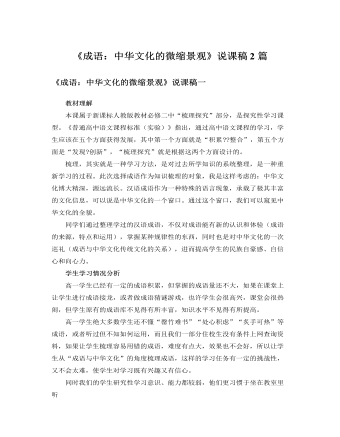
人教版高中语文必修2《赤壁赋》说课稿3篇
[教学反思]人教版高中语文必修二第三单元安排了《兰亭集序》《赤壁赋》《游褒禅山记》三篇古代山水游记散文,它们借游赏之事,探索生命的意义、治学的道理。师者,所以传道、授业、解惑也。高中的教材选用的都是历史经典名篇,每一篇都闪烁着儒道释等百家光辉的思想。编者要老师传道的意图很明显。即非如此,看着这些影响历代、影响世界的如日月之耀眼光华的伟大思想就躺在我们的教科书里,又如何能不讲呢?所以,我将本课的教学重难点拟定为:帮助学生建立积极的生死观,掌握多角度看问题的正确的思想方法。当然,也让学生领会了融写景、抒情、说理于一炉的大家手法。整堂课各教学环节,环环相扣,过渡自然,读、思、议、写训练到位,而且全部围绕“生死观”展开,如一篇形散神不散的散文。
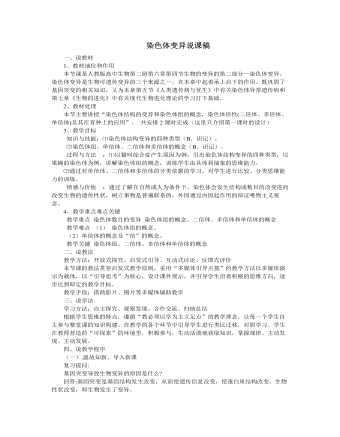
人教版高中生物必修2染色体变异说课稿
四、说教学程序(一).温故知新、导入新课复习提问:基因突变导致生物变异的原因是什么?回答:基因突变是基因结构发生改变,从而使遗传信息改变,使蛋白质结构改变、生物性状改变,即生物发生了变异。那么,基因是什么?它和染色体又有何关系?回答:基因是有遗传效应的DNA片断,染色体是DNA的载体,基因在染色体上呈线形排列。引出新知:对于一个生物体来说,正常情况下,其染色体的结构和数量都是稳定的。但在自然条件或人为因素的影响下,染色体的结构和数量均会发生改变,从而导致生物性状的改变,这就属于染色体变异。(二).把握重点、突破难点重点的把握:1、染色体结构的变异播放影片:猫叫综合征幼儿。让学生观察: 患儿哭声轻、音调高,很像猫叫。教师补充: 患儿的征状---两眼较低、耳位低下,存在着严重的智力障碍。阐述病因---染色体片段缺失

人教版高中英语必修1Journey Down the Mekong说课稿
2. let the Ss complete the forms paragraph by paragraph. Purpose here is to help Ss to get the habit of reading a passage as a whole, and pay attention to the organization of the text, as a result the Ss will fully understand the whole passage.3. ask Ss to retell the passage with the help of the key words in the form.Since the Ss in the class are in different levels, so I let them to fill in the blank to understand the meaning of the words and phrases better. ( That’s all for the while-reading. Now let’s move to the fifth step.)Step V: Post-reading (10mins) ---DiscussionIn this part students are asked to discuss in groups and list Wang Kun’s and Wang Wei’s attitudes about the trip. After that, Ss are encouraged to express their attitudes with the whole class. Collect their answers and don’t forget to praise them even if their answers may not be perfect.In this activity, discussion provides a vivid and active learning environment for Ss to communicate in English with newly learned language items. (Finally it comes to the homework.)StepⅥ: Homework (1min)1. Ss are required to read the text again after class and figure out the meaning of some complex sentences.2. Do the exercises on P19; This can help Ss to consolidate what they’ve learnt and make preparation for the next lessonPart4. Blackboard design.(说板书设计)On the top, there is the title of this lesson. On the left, there are main ideas for each paragraph. On the right, there are some new words and expressions.Unit 3 Travel journalJourney down the MekongMain idea of each para.:Para1: deciding to take a great bike trip along the Mekong river.Para2: Different attitudes between Wang kun and Wang wei.

人教版高中英语必修4Body Language说课稿4篇
Textbook: Senior English for China (Book 4), by Liu Daoyi Time Allotment: 1 period (40 minutes)Date: March 20, 2014Teaching aids: blackboard, Multi-media, Power Point, chalk I. Text Analysis (教材分析)This unit is about body language, and the text selected in the reading part demonstrates the difference and similarity of body language in many parts of the world. Through learning this passage, students are required to raise their awareness of using body language in different parts of the world. As body language is closely related to our daily life, it is easy to arouse students’ interest in learning this text. Reading skills and speaking training are designed around the text.II. Teaching Objectives (教学目标)By the end of the lesson, students will be able to:1. Language Skill Objective(语言技能目标): develop reading ability (skimming and scanning)as well as speaking ability.2. Cultural Knowledge Objective(文化知识目标): know about the cultural differences of using body language.3. Affective Objective(情感目标): increase students’ awareness of using body language correctly in different cultures. III.Teaching Focuses and Difficulties(教学重点和难点)1. Teaching Focuses(教学重点): the difference and similarity of body language in many parts of the world.2. Teaching Difficulties(教学难点): develop students’ reading abilities of skimming and scanning and ask the students to show their opinions with fluent English.

人教版高中英语必修2Cultural Relics说课稿2篇
Ⅲ. Analysis of the teaching material:The topic of this unit is cultural relics. Students are quite interested in topics about different cultures around the world. This is the second period of the whole unit. As a reading class, the passage mainly talks about the history of the amber room (how it was made, sent as a gift, lost and rebuilt).According to the new national curriculum, when teaching reading, much emphasis should be put on training the students’ reading skills.Ⅳ. Teaching objectives1. Language objectives:1) Students are required to master the key words and phrases occurred in the passage (e.g. amazing, decorate, belong, in return, less than etc.)2) Students are required to learn the attributive clause and acquire the sentence pattern.2. 1) Students are required to describe a certain thing by using the new sentence patterns.2) Students are required to master two kinds of reading skills—skimming and scanning, and learn to use them in their daily reading.3. 1) Students are required to know the history of the amber room.2) Students are required to appreciate cultural relics and understand the importance of protecting them.Ⅴ. Teaching important and difficult points1) the new words, phrases, and sentence pattern in the course of reading.2) Teaching difficult point: Help the students master two kinds of reading skills—skimmingand scanning and learn to apply them in daily use.Ⅵ. Teaching methods:Task-based method & Top-down model Ⅶ. Teaching aids: PPT, pictures, blackboard Ⅷ. Teaching procedure:

人教版高中英语必修2The Olympic Games说课稿2篇
Purpose of my design:To ask the students to do these two tasks will make the Ss predict the story of this passage. As a result, it will deepen Ss’ memory of this story because they will have their own understanding of this story.Step 3. While-readingTask 1. (Individual work _____min)Skimming: ask students to skim the text and the main ideas of each paragraph in this passage. Please read it quickly and then match the sentences with the letters.Task 2. (Individual work _____min)Scanning: read the text quickly and decide the whether the following statements are true or false and give reasons.Task 3. (Pair work _____min)Listen to the tape and fill in the banks. Then read the paragraph with expression to your partner.Task4 (individual work min)Listen to the tape again and write down the main idea in one sentence.Purpose of my design: Enable students to understand the given material better by using different reading skills. And proper competition can arouse the Ss’ interest in English learning. “Task-based” teaching method is used here todevelop the Ss’ ability of communication and also their ability of co-operation will be well trainedStep 4. Post-readingTask 1. (Individual work, pair work, group work, class work; _____min)Discussion (group of 4):1. If you were Hippomenes, would you run against Atlanta?2. Do you think Hippomenes deserved to win the race? Why or why not?Step 5. HomeworkPlease read the story again carefully after class and imagine: What will happen during the race between Hippomenes and Atlanta? Who do you think will win the race? Do you think Atlanta would marry Hippomenes? Write an end for the story with thses questions.Purpose of my design: Homework is so important and necessary for to master the knowledge they learned after class. It will check whether the Ss achieve the teaching aims.Part 5 Blackboard design

人教版高中英语必修3Festivals around the World说课稿3篇
Teaching plan for Unit 1 book3Good morning, teachers. It’s my great pleasure to be here because I can share my lesson with you and I can learn a lot from it. I’ll begin my lesson from the following four parts, the teaching material, the teaching methods, the studying methods and the teaching procedure.Firstly, let me talk about the teaching material. The content of my lesson is the reading passage festivals and celebrations of Unit 1 Festivals around the world. This passage is about festivals and celebrations. By studying this passage, we’ll enable the students to know that festivals exit everywhere, and many of festivals in different countries celebrate similar ideas. As we all know, the reading passage is the center of each unit. If the Ss can learn it well, it will be helpful to make the Ss learn the rest of this unit.After studying the teaching material, I think the teaching aims are as the followings:1. Knowledge aims:(1) The Ss can master the usage of the important words andexpressions.(2)The Ss can use the __________________ (grammar) in the proper situation.Make students know about the festivals all over the world and the detail of the festivals, such as origin, content, and the date of the holiday festivals.2. Ability aims:(1) Students can talk about festivals and celebrations in English(2) To improve the student’s reading ability, especially their skimming and scanning ability.3. Emotion aims:Make the Ss know about the foreign festivals, and respect other countries’ custom.Next, let’s come to the important points and the difficult points.The important point is how to make the Ss understand the text better and the difficult point is how can they talk about it. secondly, Teaching Methods:1. task-based Language Teaching2. Computer assisted language teaching.3. question-and–answer methodThirdly, Studying Methods:

人教版高中英语必修4Working The Land说课稿3篇
Knowledge objectives:(1) to make Ss grasp the usage of words, expressions and sentence structures: statistics, struggle, thanks to, rid of, some patterns for persuasion, the “ing” form as subject and object;(2)to use learnt knowledge to persuade sb.Ability objectives:(1) to develop Ss’ reading skills(skimming, scanning, word guessing);(2) to improve Ss’ speaking, communicating and cooperating skills.Emotional objectives:to make Ss know the contribution of Yuan,and learn his spirit and his simple life time.Teaching important and difficult points:(1) some words, expressions and sentence structures mentioned above;(2)the content of the text;(3)training their reading and speaking skills.Teaching methods: CLT, TBLT,QT.Learning strategies: CLS, QLS, TBLS.Teaching procedures:Step 1 lead-in: (1) teacher plays a piece of recent news from CCTV about the harvest of the super hybrid rice, and ask students whether they know Yuan or not, and talk about him and his contribution.(2)Brain storm: let Ss describe Yuan in their minds including his appearance, his living condition and so on.Step 2 fast reading tasks:(1)teacher introduces Yuan and super hybrid rice(2)make Ss read the text as fast as possible with questions. Such as: what’s the general ideaof this passage? What’s Yuan’ dream? (skimming and scanning skill)Step 3 intensive reading tasks(1)let Ss read the text silently, find topic sentence of each paragraph and draw the difficult sentences and the knowledge what they don’t understand.(words guessing)(2)teacher and Ss talk about the important words, expressions and sentences together, and ask Ss to retell the content of the text.(summarizing and paraphrasing)(3)teacher summarize this part.(4) read again following the courseware.

人教版高中英语必修3The million pound bank note说课稿3篇
在接下来的细读环节,我套用了高考对阅读理解的考查方式设置了5个问题,分别为三个推理判断题,一个细节题和一个主旨大意题。学生需要对文章的内容进行分析、归纳、推理、猜测等高级思维活动才能做出正确的回答。【设计意图】这一过程是对学生进行细读的训练,培养学生获取特定信息和挖掘文章深层次信息的能力。第三环节:Intensive-reading (精读) 15′第三个环节精读,既是最重要的环节,也是突破本课重难点的关键。首先,让学生思考剧本中人物看到百万英镑前后的态度发生了怎样的变化。其次,让学生仔细阅读文章,找出可以表现人物态度变化的具体的语言和动作。最后,让学生总结人物的态度发生变化的根本原因是什么,从而引出Money Talks, 供学生思考。【设计意图】通过一系列的活动培养学生学习从人物的语言和动作探究人物的心理,使学生进一步体会戏剧语言的魅力,从而对文章背后所反映的社会问题进行思考,也为下一步的讨论环节做好铺垫。
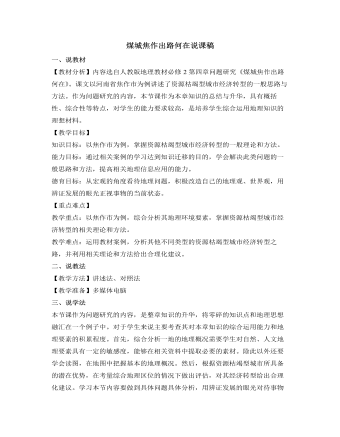
人教版高中地理必修2煤城焦作出路何在说课稿
分析过焦作市的地理概况和产业优势后,就需要针对由于资源枯竭所带来的问题提出合理化的建议。既然是谈经济转型,就应该将话题的范围明确在这一领域内。通过材料3的相关内容,我们了解到焦作市需要在产业结构调整、培育新的优势产业、增强综合竞争力等三个整改方针上下功夫。因而引导学生针对优势与不足提出建议,以三个整改方针为基准,衡量建议的可行性是锻炼学生解决此类问题的有效途径。在此我将教会学生的是解决问题方法而非案例的内容,正所谓“授之以鱼,不如授之以渔”。接下来针对学生的建议和教材资料分析所罗列的10点整改思路,由学生自由发言提出看法,通过教师的指导和学生的讨论,进而确定经济转型建议的具体方案。最后注意将建议与产业优势相对照,看建议是否都是围绕着产业优势而提出的,这样做会加深学生的印象,通过建议和优势的对应关系,将不难找出此类问题的解题思路。

部编版三年级下册语文口语交际《劝告》说课稿
统编教材语文三年级下册第七单元口语交际 《劝说》说课稿 今日,我说课的题目是统编教材小学语文三年级下册第七单元口语交际《劝说》。我主要从以下六个方面进展说课,一、说教材,二、说学情,三、说教学目标,四、说教学过程,五、说板书设计,六、说教学反思。 一、说教材 “劝说”是日常人际交往中常用的沟通方式,也是现代公民现实生活的需要。本课教材由三局部组成。 第一局部是一幅情境图,一个同学坐在楼梯扶手上往下滑。通过泡泡图里三个同学的不同劝说,引发学生思索并争论:你觉得那个同学更有可能承受谁的劝说?为什么?在比拟中帮忙学生感知、理解劝说的要领。
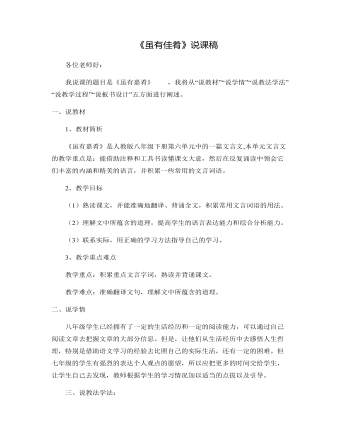
部编版语文八年级下册《礼记》二则 说课稿
一、说教材1、教材简析《虽有嘉肴》是人教版八年级下册第六单元中的一篇文言文,本单元文言文的教学重点是:能借助注释和工具书读懂课文大意,然后在反复诵读中领会它们丰富的内涵和精美的语言,并积累一些常用的文言词语。2、教学目标(1)熟读课文,并能准确地翻译、背诵全文,积累常用文言词语的用法。(2)理解文中所蕴含的道理,提高学生的语言表达能力和综合分析能力。(3)联系实际,用正确的学习方法指导自己的学习。3、教学重点难点教学重点:积累重点文言字词,熟读并背诵课文。教学难点:准确翻译文句,理解文中所蕴含的道理。
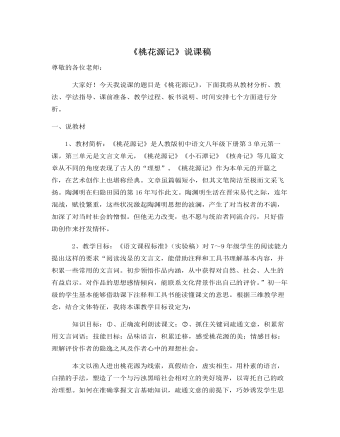
部编版语文八年级下册《桃花源记》说课稿
一、说教材1、教材简析:《桃花源记》是人教版初中语文八年级下册第3单元第一课,第三单元是文言文单元,《桃花源记》《小石潭记》《核舟记》等几篇文章从不同的角度表现了古人的“理想”。《桃花源记》作为本单元的开篇之作,在艺术创作上也堪称经典。文章虽篇幅短小,但其文笔简洁至极而文采飞扬。陶渊明在归隐田园的第16年写作此文。陶渊明生活在晋宋易代之际,连年混战,赋役繁重,这些状况激起陶渊明思想的波澜,产生了对当权者的不满,加深了对当时社会的憎恨。但他无力改变,也不愿与统治者同流合污,只好借助创作来抒发情怀。 2、教学目标:《语文课程标准》(实验稿)对7~9年级学生的阅读能力提出这样的要求“阅读浅显的文言文,能借助注释和工具书理解基本内容,并积累一些常用的文言词。初步领悟作品内涵,从中获得对自然、社会、人生的有益启示。对作品的思想感情倾向,能联系文化背景作出自己的评价。”初一年级的学生基本能够借助课下注释和工具书能读懂课文的意思。根据三维教学理念,结合文体特征,我将本课教学目标设定为:
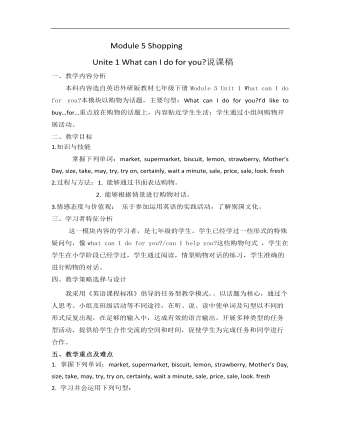
初中英语外研版七年级下册《Module 5 Shopping》说课稿
二、教学目标1.知识与技能掌握下列单词:market, supermarket,biscuit, lemon, strawberry, Mother’s Day, size, take, may, try, try on,certainly, wait a minute, sale, price, sale, look. fresh2.过程与方法:1. 能够通过书面表达购物。2. 能够根据情景进行购物对话。3.情感态度与价值观:乐于参加运用英语的实践活动,了解别国文化。
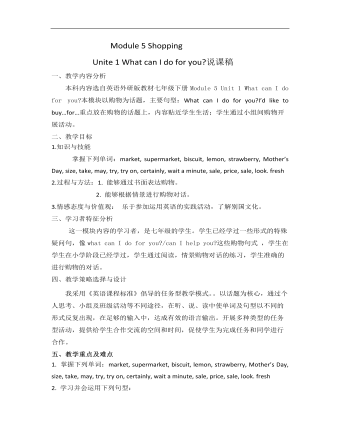
初中英语外研版七年级下册《Module 5 Shopping》说课稿
二、教学目标1.知识与技能掌握下列单词:market, supermarket,biscuit, lemon, strawberry, Mother’s Day, size, take, may, try, try on,certainly, wait a minute, sale, price, sale, look. fresh2.过程与方法:1. 能够通过书面表达购物。2. 能够根据情景进行购物对话。3.情感态度与价值观:乐于参加运用英语的实践活动,了解别国文化。三、学习者特征分析这一模块内容的学习者,是七年级的学生。学生已经学过一些形式的特殊疑问句,像what can I do for you?/can I help you?这些购物句式 ,学生在学生在小学阶段已经学过,学生通过阅读,情景购物对话的练习,学生准确的进行购物的对话。
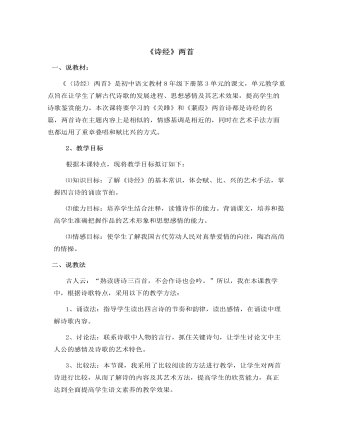
部编版语文八年级下册《诗经》二首 说课稿
一、说教材: 《〈诗经〉两首》是初中语文教材8年级下册第3单元的课文,单元教学重点旨在让学生了解古代诗歌的发展进程、思想感情及其艺术效果,提高学生的诗歌鉴赏能力。本次课将要学习的《关雎》和《蒹葭》两首诗都是诗经的名篇,两首诗在主题内容上是相似的,情感基调是相近的,同时在艺术手法方面也都运用了重章叠唱和赋比兴的方式。 2、教学目标根据本课特点,现将教学目标拟订如下:⑴知识目标:了解《诗经》的基本常识,体会赋、比、兴的艺术手法,掌握四言诗的诵读节拍。⑵能力目标:培养学生结合注释,读懂诗作的能力。背诵课文,培养和提高学生准确把握作品的艺术形象和思想感情的能力。⑶情感目标:使学生了解我国古代劳动人民对真挚爱情的向往,陶冶高尚的情操。
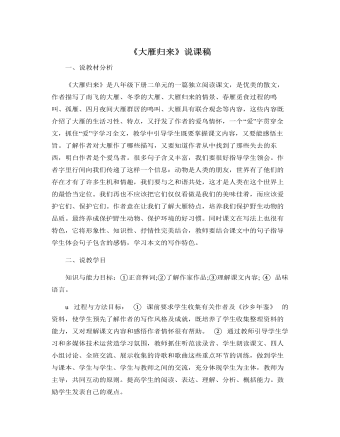
部编版语文八年级下册《大雁归来》说课稿
(三)阅读课文,整体感知。安排学生自由朗读课文,想想作者对大雁作了那些描写,勾出相关句子,想一想作者从大雁身上找到了那些“失去的东西”?这是在让学生充分发挥自己的个体作用,然后又安排四人小组讨论全班交流,意在合作探求,以便进一步领会所学的知识,最后教师利用多媒体展示参考内容,使学生进一步完整地掌握所学的知识。通过自己学、小组学、教师展示点拨,学困生也很容易地掌握所学知识,优生就更牢固地掌握了所学的知识。这样学生们对大雁的特点就有了较多了解,明白作者从大雁身上找回了什么,从中受到感悟。(三)精读课文,品味语言特点教师指导学生朗读一些优美的句子,指导学生从内容、修辞手法、说明方法、等方面去品味语言,利用多媒体来展示例句,加深学生印象,然后安排学生自己先找出课文中自己认为写的好的句子进行品味,然后四人小组讨论交流,最后全班交流,让学生资源共享。活动中我鼓励学生充分发表自己的观点,适时加以点拨,以此突破教学重难点。
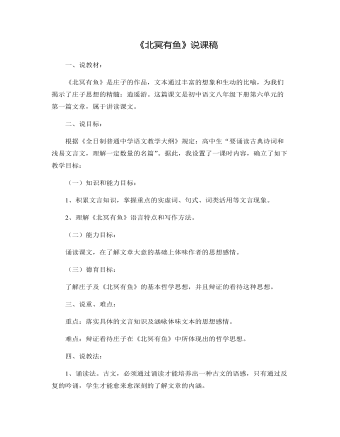
部编版语文八年级下册《庄子》二则 说课稿
一、说教材:《北冥有鱼》是庄子的作品,文本通过丰富的想象和生动的比喻,为我们揭示了庄子思想的精髓:逍遥游。这篇课文是初中语文八年级下册第六单元的第一篇文章,属于讲读课文。二、说目标:根据《全日制普通中学语文教学大纲》规定:高中生“要诵读古典诗词和浅易文言文,理解一定数量的名篇”。据此,我设置了一课时内容,确立了如下教学目标:(一)知识和能力目标:1、积累文言知识,掌握重点的实虚词、句式、词类活用等文言现象。2、理解《北冥有鱼》语言特点和写作方法。(二)能力目标:诵读课文,在了解文章大意的基础上体味作者的思想感情。(三)德育目标:了解庄子及《北冥有鱼》的基本哲学思想,并且辩证的看待这种思想。
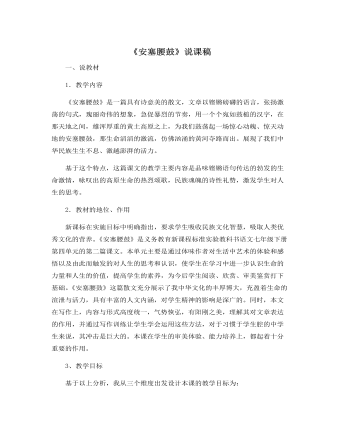
部编版语文八年级下册《安塞腰鼓》说课稿
1.教学内容《安塞腰鼓》是一篇具有诗意美的散文,文章以铿锵磅礴的语言,张扬激荡的句式,瑰丽奇伟的想象,急促暴烈的节奏,用一个个宛如鼓槌的汉字,在那天地之间,雄浑厚重的黄土高原之上,为我们鼓荡起一场惊心动魄、惊天动地的安塞腰鼓,那生命滔滔的激流,仿佛汹涌的黄河夺路而出。展现了我们中华民族生生不息、激越澎湃的活力。基于这个特点,这篇课文的教学主要内容是品味铿锵语句传达的勃发的生命激情,咏叹出的高原生命的热烈颂歌,民族魂魄的诗性礼赞,激发学生对人生的思考。2.教材的地位、作用新课标在实施目标中明确指出,要求学生吸收民族文化智慧,吸取人类优秀文化的营养。《安塞腰鼓》是义务教育新课程标准实验教科书语文七年级下册第四单元的第二篇课文。本单元主要是通过体味作者对生活中艺术的体验和感悟以及由此而触发的对人生的思考和认识,使学生在学习中进一步认识生命的力量和人生的价值,提高学生的素养,为今后学生阅读、欣赏、审美鉴赏打下基础。《安塞腰鼓》这篇散文充分展示了我中华文化的丰厚博大,充盈着生命的渲泄与活力,具有丰富的人文内涵,对学生精神的影响是深广的。
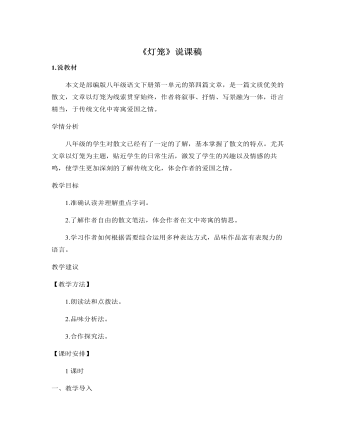
部编版语文八年级下册《灯笼》说课稿
主旨归纳本文以散文的自由笔法,抒写了作者关于灯笼的一些记忆,往昔经历、乡情民俗、诗词典故,从不同方面表达了灯笼对于作者乃至民族的重要意义。激发了作者的爱国情怀,同时表达了对时局的担忧和对未来的期望。重难导悟1.结合全文,简析作者喜爱灯笼的原因是什么?①灯笼寄托着祖父、母亲等亲人的慈爱和牵挂,也寄托着作者对亲人的感激之情;②许多乡情民俗与灯笼结下太多的缘分,给作者留下很多美好的回忆;③灯笼能为夜行人指路,温暖他人;④记录、传承着家族历史;⑤引发作者联想起古代将领挑灯看剑,抗击敌人的情景,激发爱国热情。2.文章结尾一段所表现的作者的观点态度是什么?请结合文章,进行分析并评价。作者热烈赞颂古代将军塞外点兵,挑灯看剑,英勇杀敌的气概;他们激发了作者的爱国情怀,作者热切希望冲上前线,奋勇杀敌,打击日寇;同时表达了对时局的担忧和对未来的期望,希望有更强大的力量,有更具凝聚力的精神,团结抗战,打败敌人,保卫好自己的家园。作者的爱国情怀值得肯定,这种情感在我们今天也是不可缺少的。

